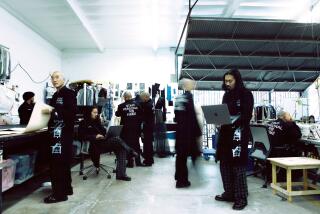Handcrafts, Machine Age Meet at Maryland Plant
CLINTON, Md. — Furniture designer and craftsman Peter Danko fits snugly into that space where handcrafts meet high tech, where the ancient harmonies of nature intersect with the streamlined ethos of the machine age, where industry and cottage industry find common ground. It’s not a well-populated space, to be sure, but it offers a multitude of possibilities.
Danko’s studio, in a block of warehouses in this suburb of Baltimore, is emblematic of his crossroads position. It’s a big, unadorned, garage-like space, with busy artisans at their machines in one warehouse, stacks of chairs and chair parts in another. As commercial as they come, in other words.
Yet, there’s a feeling of not factory but family warmth here. Peter Danko and Associates is indeed a family affair; Elizabeth Danko runs the business end of the company she owns with her husband.
The firm produces several lines of furniture, including love seats, dining tables and occasional tables, but is best known for its chairs, which range from versatile stackables to upholstered handmade cherry rockers. These can be found in restaurants (including the Rainbow Room in Rockefeller Center and the new Wright Place in the Smithsonian Institution’s National Air and Space Museum), libraries, corporate board rooms and the Museum of Modern Art--as well as in private homes.
Danko furniture, which is sold mostly through architects and interior designers, has echoes of art nouveau in its sinuous organic shapes. Its spare, unfussy lines recall the Bauhaus “form follows function” dictum. In short, it is a synthesis of classic and contemporary stylings, clean-lined and simple enough to please modern purists, but flowing and curvilinear enough for romantics.
Although their handsome lines and wood construction might indicate otherwise, nearly all of Danko products are mass-produced. And with his most famous invention, the Bodyform chair, Danko expanded into advanced technology: These chairs are produced not by the hand of man but by a complex system of computerized robotics.
Her husband’s career has, Elizabeth Danko says, progressed in a very different manner from that of many artisans. Whereas they might turn out simple production pieces until they can afford to do the one-of-a-kind work they love, he actually prefers the challenges of mass production to the prestige of custom jobs.
“For every piece he makes, he’ll do up to 20 prototypes,” she says. “All are hand-built, and each one is a little bit different. To him, that’s the challenge: to take a design and perfect it, so that it’s beautiful and well designed and easy to manufacture, as well. He would rather do that than just be a craftsman, and have each piece be different.”
Danko says: “If you’re going to do something that’s artistic, it’s nice to be able to do it more than once. I guess it comes down to this: I spend so much time getting something perfect that I could never do one of a kind. The last chair I designed took 2 1/2 years.”
When Danko entered the furniture business, he saw himself more as a sculptor than a cabinetmaker, in the tradition of 17th- and 18th-Century craftsmen whose work involved much carving and ornamentation.
His early ‘70s style was distinctive. He would take large blocks, made of layers of laminated wood veneers, and carve them in his own curvaceous style. His portfolio shows a variety of his work from this period: a desk that is supported on voluptuous, almost human legs; a sofa made of snakelike wooden tendrils supporting bulbous leather cushions, a lamp that’s a Paul Klee squiggle.
“These are all antiques now,” he says with a laugh.
One particular inspiration was the bentwood technique developed by 19th-Century designer and manufacturer Michael Thonet. Danko improved on the Thonet principles by developing his own molds that take sandwiched layers of veneer and shape them under pressure into chair forms. Any number of pieces can be made from a single successful mold.
“A lot of time goes into the mold,” he says. “Before you make your production mold you make your prototype molds, and keep throwing them away until you get it exactly right.”
The Bodyform chair, designed in 1976 and first manufactured two years later, has taken Danko’s process to its high-tech extreme. The chairs are made from a single sheet of plywood, cunningly cut and molded for strength and comfort.
“The neat thing about this chair also is that it’s now made totally by a computerized machine station,” Danko says. “I guess robot would be the word you’d use.
“After it’s molded, it has all this glue oozing out, and the layers are uneven, so the layers have to be machined. So they have this computerized machine that does all the edges and levels the chair. It machines the hand-hold in the back, and if the chair will be upholstered, it drills the holes for the seat. Since this is the only chair made out of one piece of wood, it’s the only chair where you can do all these operations at once.”
The factory, Sauder Manufacturing in Stryker, Ohio, makes the Bodyform chairs.
While Sauder is responsible for most of the mass-produced Danko furniture, the workshop in Clinton, where Danko moved three years ago, handles smaller orders. They make the parts for the new Waveform chair and the Lazy Spiral, an Art Deco-influenced adjustable chair “named for our favorite neighboring galaxy.”
“It’s still very much a craft shop,” Danko says. “That’s kind of where I like it. If I was really big, I wouldn’t be able to play in my shop any more, and if I was really small, I’d be working all the time just to pay for my shop. There’s a happy area in between, and I’m pretty close to being where I want to be.”


